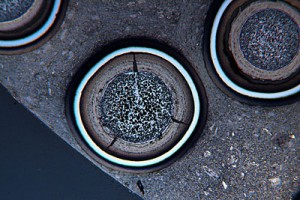South African-born and Idaho-based researcher Isabella van Rooyen has solved a problem of longstanding interest to nuclear researchers according to a Jan. 3, 2014 news item on Nanowerk,
Some come to Idaho to travel the highways that lead to the Tetons, to Yellowstone, to small towns and big adventures. Idaho National Laboratory researcher Isabella van Rooyen came, all the way from South Africa, looking for a piece of silver 500,000 times smaller than a poppy seed.
The silver was somewhere inside irradiated tristructural-isotopic (TRISO) fuel particles — a safer, more efficient, next-generation nuclear fuel — the “poppy seed” in question. Break a TRISO fuel particle open and it looks like a jaw breaker on the inside. An outer shell of carbon coats a layer of silicon carbide, which coats the uranium center where the energy-releasing fission happens. These layers are meant to contain the radioactive products of fission, which includes little bits of silver. Containment of the radioactive material is built right into the fuel itself.
But it doesn’t always work perfectly. Occasionally, in just one or two out of 100 particles, silver escapes the center. It moves around the particle, and potentially gets out. Since the 1970s, scientists have been wondering exactly how this happens.
“I find it absolutely fascinating,” said Van Rooyen. She has been studying the TRISO-silver problem since 2006. “I have a natural tendency to know what is going on [inside the fuel].”
The Jan. 2, 2014 Idaho National Laboratory news release by Shannon Palus, which originated the news item, details how scientists saw the problem,
The silver seems to jump the silicon carbide layer as though by magic. There is no obvious point of exit, or forcible silver-shaped hole, to be found. The transport mechanism that brings it from the inside out is a mystery that spans decades. It is a wrinkle in the plan to make TRISO the most efficient, and potentially the safest, fuel of the future.
In South Africa, Van Rooyen worked on a number of hypotheses for the TRISO problem. For example, did it piggyback out of the TRISO fuel particle attached to another element? Were there almost-too-tiny-to-see nanotubes forming in the silicon carbide layer?
One possibility seemed most probable to Van Rooyen. But to test it, to even begin to see if it was correct, she needed to be able to get a closer look. And she needed irradiated TRISO fuel.
Getting back to the notion of the irradiated tristructural-isotopic (TRISO) fuel particles being like a jawbreaker on the inside, i.e., made up of many layers, scientists have a term for the networks where each layer meets the next and where the grains that make up the layers align with each other, nanoroads. This concept inspired Van Rooyen’s approach (from the news release),
Could the nanoroads be the silver precipitate’s path out of the TRISO fuel particle? They do offer a path of lesser resistance, a point of potential weakness in the silicon carbide. The first step would be to see if silver could be found along these roads.
Van Rooyen’s method of investigation was a Scanning Transmission Electron Microscope operated by Yaqio Wu, a Boise State University research associate professor and instrument lead of the Materials and Characterization Suite at the Center for Advanced Energy Studies. Somewhere along one of the nanoroad grain boundaries, Van Rooyen and Wu, along with materials engineer Tom Lillo, might be able to spot the silver precipitate.
“We were really like private investigators,” Van Rooyen said. The silver’s presence on the nanoroads — if that’s where it was — would be a lynchpin clue in the mystery.
After a year of patience and administrative work, she finally got her hands on actual, irradiated samples.
…
At a research briefing on the morning the team received the samples, they discussed the fact that they were looking for a needle in a haystack. For one, the bits of silver were so small. And not all TRISO particles emit silver. Would there even be silver in the specific sample they were looking at?
…
After years of exploring and discarding various hypotheses about the location of the silver, Van Rooyen and her team placed the irradiated TRISO particle under the electron microscope. This would be the closest, most careful look at the nanoroads in irradiated TRISO ever.
On that very afternoon, microscope operator Wu zoomed in and they found the silver precipitate. It was wedged at the intersection of two layers of TRISO coating, at the nanoroads between grains.
It was “an absolute wow moment,” said Van Rooyen. “We made such a commotion that people from other labs were coming to have a look.”
The journey is far from over. Next, Van Rooyen and her team will observe the silver to see how far it moves through the silicon carbide and try to determine exactly how it is able to get out. Time and hard work will tell if the nanoroads hypothesis is correct.
As is always the case, there’s the lead scientist and then there’s everyone else who helped make the discovery possible:
In addition to her colleagues Lillo and Wu, Van Rooyen would like to acknowledge Jim Madden for focused ion beam sample preparation; Jason Harp for isotope calculations; Joanne Taylor (Idaho State University); and Kristi Moser-McIntire (ISU) from CAES for their organization and support in the licensing of the CAES facility, which enabled the team to bring irradiated samples to the microscope.
Here’s an image of the TRISO particles,
